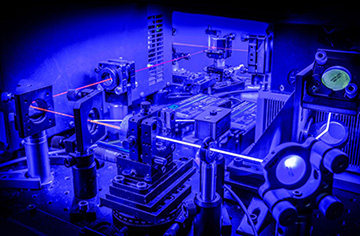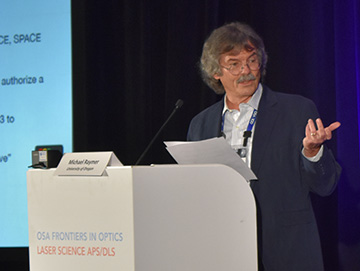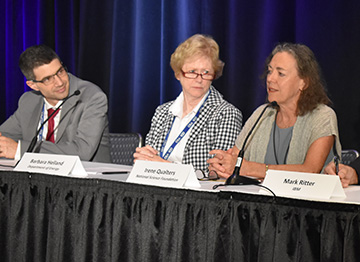
Experimental set up used for the creation of entangled photons for a quantum Bell experiment. [Image: Kevin J. Mitchell, University of Glasgow]
Given the sometimes glacial timescales of the U.S. Congress, the effort to build a U.S. National Quantum Initiative (NQI) has proceeded at what seems like breakneck speed. First presented to congressional staff in a National Photonics Initiative (NPI)-sponsored white paper just over a year ago, the NQI had found its way into a US$1.275 billion piece of enabling legislation by the middle of this year. A week ago, that legislation passed by voice vote in the U.S. House of Representatives, and it’s now under active review in the U.S. Senate.
It would seem that, the best spirit of “quantum weirdness” and entanglement, the drive for quantum technology has caused Republicans and Democrats to behave “non-classically,” and to act with surprising correlation. But what happens if the measure becomes law? That was the theme of a panel discussion Wednesday at the 2018 Frontiers in Optics/Laser Science conference in Washington, D.C. The panel brought together five stakeholders from government, academia and industry to tap into their thoughts on the nascent NQI’s priorities.
The optics-quantum connection
Michael Raymer of the University of Oregon—who, with Christopher Monroe of the University of Maryland, co-authored the original white paper, and who has been a key force in moving the project forward—acted as the discussion’s moderator. In the course of briefly reviewing the project’s history, Raymer noted that the idea for the initiative was hatched almost two years ago at another FiO+LS meeting.
The connection between OSA and quantum technology initiatives, including this panel discussion, is a natural one, Raymer suggested. “Optics can do everything, and everything is optics,” he said. “Optics cuts across all fields, and a lot of [quantum] support technology comes from the optical community.” He added that the NQI “has very broad support across industry as well as academia.”

Michael Raymer, University of Oregon, at FiO+LS 2018.
The NQI plan
The basic plan of the NQI has three components, sketched out by Raymer in his introductory remarks. One component is the creation of five to ten large innovation labs nationwide, that would “bring engineers, mathematicians, computer scientists, physicists, chemists and material scientists all together in a very-well-funded, large center.” These centers, he said, would exist “to actually build quantum hardware” that can serve as testbeds as “a stepping stone to eventual commercialization.”
A second component lies in computer-access programs to allow for the development and implementation of quantum algorithms using the testbed hardware. And the third piece is a quantum research network to support fundamental research by smaller academic groups.
Raymer also touched on the NQI proposal’s recognition of quantum tech’s unique educational needs. “Industry needs trained quantum engineers,” he said, “so we also need to develop new programs in training quantum engineers—whatever that may mean.” Companies and universities actually aren’t sure yet what a “quantum engineer” actually is, Raymer suggested, so part of the task ahead is to flesh out that job description and fashion the new academic programs in response.
Training the quantum workforce
The need for better training, at multiple levels, was also a key theme in the subsequent panel discussion, which featured five government, industry and academic figures with a strong stake in quantum. Mark Ritter, the senior manager of quantum information systems at IBM, noted that the company has “had trouble hiring well-qualified, well-trained people—it’s just very hard.” He added that he’s seen certain professionals leave the United States for other countries because the long-term funding prospects looked better for quantum overseas. “The National Quantum Initiative,” Ritter said, “signals that we’re going to support a long-term program.”
Sir Peter Knight, a former OSA president, an emeritus professor of Imperial College London, and a significant figure in the development of the U.K. National Quantum Technologies Programme (NQTP), said that “we have exactly the same issues” in Britain—“finding suitably qualified and experienced personnel.” In light of that, he noted, some 15 percent of the NQTP budget is allocated to spending on new training programs.
What form should such training take? Irene Qualters, the director of computer and information science and engineering at the U.S. National Science Foundation, argued that, while “curriculum is an important piece,” it’s not enough to build a quantum workforce. “It’s really important that you build the skills through research experience.”
Jacob Taylor, the assistant director for quantum information science with the White House Office of Science and Technology Policy (OSTP), added that, through his teaching experience, he had learned that “quantum engineering isn’t a field … and engineers are also not a particular breed of person; there are many types of engineers.” Training programs, he suggested, need to take into account that diversity and focus on producing “people with the knowledge that makes them interesting to companies.”
Engaging overseas efforts
Another key theme was the international dimension: How should the NQI “cooperate or compete” with international programs, such as the much-discussed program in China, or the burgeoning quantum efforts in Europe? Knight noted the natural common ground in these efforts and others, as all of them are addressing the same problem space.
“Looking at the U.S. NQI compared with the U.K. program,” Knight joked, “you’ve violated the [quantum] ‘no-cloning’ theorem … the U.S. initiative very strongly mirrors what we’ve been trying to do in the U.K., and for the same sensible reasons.” Among the important areas of international cooperation and collaboration that Knight and other panel members cited are the development of international standards for quantum technology, and the refinement of security protocols.
“International cooperation is not only possible; it’s necessary,” according to Ritter of IBM. “CMOS showed an example of that. IBM and Intel didn’t build all of their fab equipment; they collaborated with other people to make the fab equipment and develop the technologies. This will also happen in this realm of quantum science.”

Left to right: Jacob Taylor, White House Office of Science and Technology Policy; Barbara Helland, U.S. Department of Energy; and Irene Qualters, U.S. National Science Foundation, at an FiO+LS 2018 panel discussion on the National Quantum Initiative.
Leveraging the innovation economy
The NQI’s biggest raison d'être, of course, is to enhance cooperation and coordination among the agencies of the U.S. government that are involved in quantum science and its funding. “You’ve actually had a massive spend on quantum in the United States, in a number of agencies that possibly could be regarded as competitors rather than collaborators,” said Knight. “I believe this initiative will enable us to break down those stovepipes, to do things of substance together.”
Barbara Helland, with the U.S. Department of Energy’s Office of Science—which, she said, supports 40 percent of U.S. physical-science research—pointed to the U.S. High-Performance Computing and Communication Initiative of 1991 as “an excellent example of what can be achieved with a national initiative.”
“In the 1990s,” said Helland, “the use of computers as tools for scientific exploration was at a stage similar to where we are with quantum today,” she said. The national initiative helped the various U.S. agencies come together with understood roles, to define “grand-challenge problems,” flesh out R&D and training requirements, and leverage government investments in a way that ultimately led to U.S. leadership in high-performance computing. “I think we can do the same thing with a quantum initiative.”
Taylor of OSTP agreed that the NQI is answering a fundamental need to bring national efforts together. “We can do a better job of keeping the science moving forward in a cohesive community,” he said, “rather than letting independent and competing interests fragment things.”
“The innovation economy that we have is a tremendous thing,” said Taylor. “We need to leverage it in a science-first way.”
